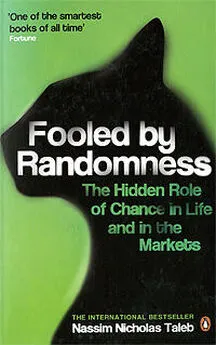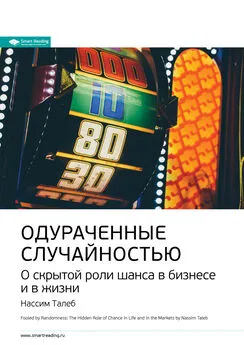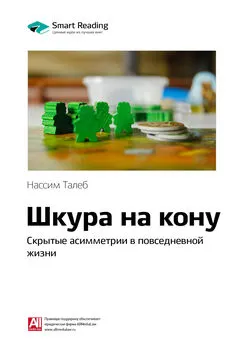Нассим Талеб - Чёрный лебедь. Под знаком непредсказуемости
- Название:Чёрный лебедь. Под знаком непредсказуемости
- Автор:
- Жанр:
- Издательство:КоЛибри
- Год:2009
- Город:Москва
- ISBN:978-5-389-00573-0
- Рейтинг:
- Избранное:Добавить в избранное
-
Отзывы:
-
Ваша оценка:
Нассим Талеб - Чёрный лебедь. Под знаком непредсказуемости краткое содержание
За одно только последнее десятилетие человечество пережило ряд тяжелейших потрясений: 11 сентября 2001 года, война в Осетии, мировой финансовый кризис. Все эти события, представляющиеся нам сейчас закономерными, казались абсолютно невозможными, пока они не произошли. Сорокадевятилетний ливанец, выпускник Сорбонны и нью-йоркский финансовый гуру Нассим Талеб называет такие непредсказуемые происшествия Черными лебедями. Он убежден: именно они дают толчок как истории в целом, так и существованию каждого отдельного человека. И чтобы преуспеть, надо знать, как с ними обращаться. Сразу после выхода этой книги автор блестяще продемонстрировал свою «не-теорию» на практике: на фоне финансового кризиса компания Талеба заработала (а не потеряла!) для инвесторов полмиллиарда долларов.
Из главного еретика Уолл-стрит, который в одиночку выступил против легиона футурологов и аналитиков, Нассим Талеб превратился в фигуру, чье влияние распространяется далеко за пределы финансового мира.
Чёрный лебедь. Под знаком непредсказуемости - читать онлайн бесплатно ознакомительный отрывок
Интервал:
Закладка:
Kahneman, D., J. L. Knetsch, and R. H. Thaler, 1986, «Rational Choice and the Framing of Decisions.» Journal of Business 59(4): 251–278.
Kahneman, D., and D. Lovallo, 1993, «Timid Choices and Bold Forecasts: A Cognitive Perspective on Risk-taking.» Management Science 39:17–31.
Kahneman, D., and A. Tversky, 1972, «Subjective Probability: A Judgment of Representativeness.» Cognitive Psychology 3: 430–454.
-, 1973, «On the Psychology of Prediction.» Psychological Review 80:237–251.
-, 1979, «Prospect Theory: An Analysis of Decision Under Risk.» Econometrica 46(2): 171–185.
-, 1982, «On the Study of Statistical Intuitions.» In D. Kahnerrian, P. Slovic, and A. Tversky, eds., Judgment Under Uncertainty: Heuristics and Biases. Cambridge: Cambridge University Press.
-, 1996, «On the Reality of Cognitive Illusions.» Psychological Review 103: 582–591.
-, eds., 2000, Choices, Values, and Frames. Cambridge: Cambridge University Press.
-, 1991, «Anomalies: The Endowment Effect, Loss Aversion, and Status Quo Bias.» In D. Kahneman and A. Tversky, eds., 2000.
Kaizoji, Taisei, 2003, «Scaling Behavior in Land Markets.» Physica A: Statistical Mechanics and Its Applications 326(1–2): 256–264.
Kaizoji, Taisei, and Michiyo Kaizoji, 2004, «Power Law for Ensembles of Stock Prices.» Physica A: Statistical Mechanics and Its Applications 344(1–2), Applications of Physics in Financial Analysis 4 (APFA4) (December 1): 240–243.
Katz, J. Sylvan, 1999, «The Self-similar Science System.» Research Policy 28(5): 501–517.
Keen, Steve, 2001, Debunking Economics: The Naked Emperor of the Social Classes. London: Pluto Press.
Kemp, C, and J. B. Tenenbaum, 2003, «Theory-based Induction.» Proceedings of the Twenty-fifth Annual Conference of the Cognitive Science Society, Boston, Mass.
Keren, G., 1988, «On the Ability of Assessing Non-verdical Perceptions: Some Calibration Studies.» Acta Psychologica 67: 95–119.
-, 1991, «Calibration and Probability Judgments: Conceptual and Methodological Issues.» Acta Psychologica 77: 217–273.
Keynes, JohnMaynard, 1920, Treatise on Probability. London: Macmillan.
-, 1937, «The General Theory.» Quarterly Journal of Economics 51: 209–233.
Kidd, John В., 1970, «The Utilization of Subjective Probabilities in Production Planning.» Acta Psychologica 34(2/3): 338–347.
Kim, E. Han, Adair Morse, and Luigi Zingales, 2006, «Are Elite Universities Losing Their Competitive Edge?» NBER Working Paper 12 245.
Kindleberger, Charles P., 2001, Manias, Panics, and Crashes. New York: Wiley.
King, Gary, and Langche Zeng, 2005, «When Can History Be Our Guide? The Pitfalls of Counterfactual Inference.» Working Paper, Harvard University.
Kirkpatrick, Mark, and Lee Alan Dugatkin, 1994, «Sexual Selection and the Evolutionary Effects of Copying Mate Choice.» Behavioral Evolutionary Sociobiology 34: 443–449.
Klayman, J., 1995, «Varieties of Confirmation Bias.» In J. Busemeyer,R. Hastie, and D. L. Medin, eds., Decision Making from a Cognitive Perspective. The Psychology of Learning and Motivation 32: 83–136. New York: Academic Press.
Klayman, J., and Y.-W. Ha, 1987, «Confirmation, Disconfirmation, and Information in Hypothesis Testing.» Psychological Review 94: 211–228.
Klayman, Joshua, Jack B. Soil, Claudia Gonzalez-Vallejo, and Sema Barlas, 1999, «Overconfidence: It Depends on How, What, and Whom You Ask.» Organizational Behavior and Human Decision Processes 79(3): 216–247.
Klebanoff, Arthur, 2002, The Agent. London: Texere.
Klein, Gary, 1998, Sources of Power: How People Make Decisions. Cambridge: The MIT Press.
Knight, Frank, 1921, 1965, Risk, Uncertainty and Profit. New York: Harper and Row.
Koehler, J. J., B. J. Gibbs, and R. M. Hogarth, 1994, «Shattering the Illusion of Control: Multishot Versus Single-shot Gambles.» Journal of Behavioral Decision Making 7:183–191.
Koestler, Arthur, 1959, The Sleepwalkers: A History of Man's Changing Vision of the Universe. London: Penguin.
Korda, Michael, 2000, Another Life: A Memoir of Other People. New York: Random House.
Koriat, A., S. Lichtenstein, and B. Fischhoff, 1980, «Reasons for Confidence.» Journal of Experimental Psychology: Human Learning and Memory 6:107–118.
Kreps, J., and N. B. Davies, 1993, An Introduction to Behavioral Ecology, 3rd ed. Oxford: Blackwell Scientific Publications.
Kristeva, Julia, 1998, Time and Sense. New York: Columbia University Press.
Kruger, J., and D. Dunning, 1999, «Unskilled and Unaware of It: How Difficulties in Recognizing One>s Own Incompetence Lead to Inflated Self-Assessments.» Journal of Personality and Social Psychology 77(6): 1121–1134.
Kunda, Ziva, 1990, «The Case for Motivated Reasoning.» Psychological Bulletin 108:480–498.
-, 1999, Social Cognition: Making Sense of People. Cambridge: The MIT Press.
Kurz, Mordecai, 1997, «Endogenous Uncertainty: A Unified View of Market Volatility.» Working Paper: Stanford University Press.
Kyburg, Henry E., Jr., 1983, Epistemology and Inference. Minneapolis: University of Minnesota Press.
Lad, F., 1984, «The Calibration Question.» British Journal of the Philosophy of Science 35: 213–221.
Lahire, Bernard, 2006, La condition litteraire. Paris: Editions La Decouverte.
Lakoff, George, and Mark Johnson, 1980, Metaphors We Live By. Chicago: The University of Chicago Press.
Lamont, Owen A., 2002, «Macroeconomic Forecasts and Microeconomic Forecasters.» Journal of Economic Behavior and Organization 48(3): 265–280.
Lane, R. D., E. M. Reiman, M. M. Bradley, P. J. Lang, G. L. Ahern, R. J. Davidson, and G. E. Schwartz, 1997, «Neuroanatomical correlates of pleasant and unpleasant emotion.» Neuropsychologia 35(11): 1437–1444.
Langer, E. J., 1975, «The Illusion of Control.» Journal of Personality and Social Psychology 32: 311–328.
Larrick, R. P., 1993, «Motivational Factors in Decision Theories: The Role of Self-Protection.» Psychological Bulletin 113: 440–450.
Leary, D. E., 1987, «From Act Psychology to Probabilistic Functionalism: The Place of Egon Brunswik in the History of Psychology.» In M. G. Ash and W. R. Woodward, eds., Psychology in Twentieth-century Thought and Society. Cambridge: Cambridge University Press.
LeDoux, Joseph, 1998, The Emotional Brain: The Mysterious Underpinnings of Emotional Life. New York: Simon 8c Schuster.
-, 2002, Synaptic Self: How Our Brains Become Who We Are. New York: Viking.
Le Goff, Jacques, 1985, Les intellectuels au moyen age. Paris: Points Histoire.
Levi, Isaac, 1970, Gambling with Truth. Cambridge, Mass.: The MIT Press.
Lichtenstein, Sarah, and Baruch Fischhoff, 1977, «Do Those Who Know More Also Know More About How Much They Know? The Calibration of Probability Judgments.» Organizational Behavior and Human Performance 20:159–183.
Lichtenstein, Sarah, and Baruch Fischhoff, 1981, «The Effects of Gender and Instructions on Calibration.» Decision Research Report 81–5. Eugene, Ore.: Decision Research.
Lichtenstein, Sarah, Baruch Fischhoff, and Lawrence Phillips, 1982, «Calibration of Probabilities: The State of the Art to 1980.» In D. Kahneman, P. Slovic, and A. Tversky, eds., Judgment Under Uncertainty: Heuristics and Biases. Cambridge: Cambridge University Press.
Lim, Т., 2001, «Rationality and Analysts' Forecast Bias.» Journal ofFinanee 56(1): 369–385.
Lissowski, Grzegorz, Tadeusz lyszka, and Wlodzimierz Okrasa, 1991, «Principles of Distributive Justice: Experiments in Poland and America.» Journal of Conflict Resolution 35(1): 98–119.
Liu, Jing, 1998, «Post-Earnings Announcement Drift and Analysts' Forecasts.» Working Paper, UCLA.
Loewenstein, G. F., E. U. Weber, С. K. Hsee, and E. S. Welch, 2001, «Risk as Feelings.» Psychological Bulletin 127: 267–286.
Loewenstein, George, 1992, «The Fall and Rise of Psychological Explanations in the Economics of Intertemporal Choice.» In George Loewenstein and Jon Elster, eds., Choice over Time. New York: Russell Sage Foundation.
Loftus, Elizabeth F., and Katherine Ketcham, 1994, The Myth of Repressed Memory: False Memories and Allegations and Sexual Abuse. New York: St. Martin's Press.
Lotka, Alfred J., 1926, «The Frequency Distribution of Scientific Productivity.» Journal of the Washington Academy of Sciences 16(12): 317–323.
Lowenstein, R., 2000, When Genius Failed: The Rise and Fall of Long-Term Capital Management. New York: Random House.
Lucas, Robert E., 1978, «Asset Prices in an Exchange Economy.» Econometrica 46:1429–1445.
Luce, R. D., and H. Raiffa, 1957, Games and Decisions: Introduction and Critical Survey. New York: Wiley.
Mach, Е., 1896, «On the Part Played by Accident in Invention and Discovery.» Monist 6:161–175.
Machina, M. J., and M. Rothschild, 1987, «Risk.» In J. Eatwell, M. Mil-gate, and P. Newman, eds., 1987.
Magee, Bryan, 1985, Philosophy and the Real World: An Introduction to Karl Popper La Salle, 111.: Open Court Books.
-, 1997, Confessions of a Philosopher. London: Weidenfeld &c Nicolson.
Maines, L. A., and J. R. Hand, 1996, «Individuals' Perceptions and Misperceptions of Time-series Properties of Quarterly Earnings.» Accounting Review 71: 317–336.
Makridakis, S., A. Andersen, R. Carbone, R. Fildes, M. Hibon, R. Lewandowski, J. Newton, R. Parzen, and R. Winkler, 1982, «The Accuracy of Extrapolation (Time Series) Methods: Results of a Forecasting Competition.» Journal of Forecasting 1: ш-153.
Makridakis, S., C. Chatfield, M. Hibon, M. Lawrence, T. Mills, K. Ord, and L. F. Simmons, 1993, «The M2-Competition: A Real-Time Judgmentally Based Forecasting Study» (with commentary). International Journal of Forecasting 5:29.
Makridakis, S., and M. Hibon, 2000, «The Мз-Competition: Results, Conclusions and Implications.» International Journal of Forecasting 16:451–476.
Mandelbrot, В., 1963, «The Variation of Certain Speculative Prices.» Journal of Business 36(4): 394–419.
Mandelbrot, Benoit, 1965, «Information Theory and Psycholinguistics.» In B. Wolman and E. Nagel, eds., Scientific Psychology: Principles and Approaches. New York: Basic Books.
-, 1975, Les objets fractals: forme, hasard, et dimension. Paris: Flammarion.
-, 1982, The Fractal Geometry of Nature. New York: W. H. Freeman and Company.
-, 1997a, Fractales, hasard et finance. Paris: Flammarion.
-, 1997b, Fractals and Scaling in Finance: Discontinuity, Concentration, Risk. New York: Springer-Verlag.
Mandelbrot, Benoit, and Nassim Nicholas Taleb, 2006a, «A Focus on the Exceptions That Prove the Rule.» In Mastering Uncertainty: Financial Times Series.
-, 2006b, «Matematica della sagessa.» // Sole 24 Ore, October 9.
-, 2007а, «Random Jump Not Random Walk.» Manuscript.
-, 2007b, «Mild vs. Wild Randomness: Focusing on Risks that Matter.» Forthcoming in Frank Diebold, Neil Doherty, and Richard Herring, eds., The Known, the Unknown and the Unknowable in Financial Institutions. Princeton, N.J.: Princeton University Press.
Mandler, J. M., and L. McDonough, 1998, «Studies in Inductive Inference in Infancy.» Cognitive Psychology 37: 60–96.
Margalit, Avishai, 2002, The Ethics of Memory. Cambridge, Mass.: Harvard University Press.
Markowitz, Harry, 1952, «Portfolio Selection.» Journal of Finance (March): 77–91.
-, 1959, Portfolio Selection: Efficient Diversification of Investments, 2nd ed. New York: Wiley.
Marmott, Michael, 2004, The Status Syndrome: How Social Standing Affects Our Health and Longevity. London: Bloomsbury.
Marr, D., 1982, Vision. New York: W. H. Freeman and Company.
Читать дальшеИнтервал:
Закладка:










